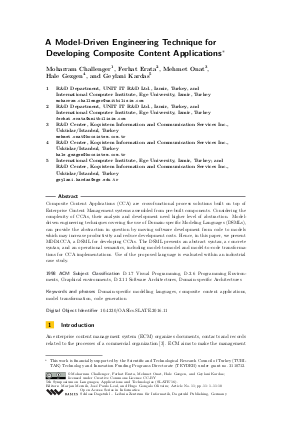A Model-Driven Engineering Technique for Developing Composite Content Applications
Authors Moharram Challenger, Ferhat Erata, Mehmet Onat, Hale Gezgen, Geylani Kardas
-
Part of:
Volume:
5th Symposium on Languages, Applications and Technologies (SLATE'16) (SLATE 2016)
Part of: Series: Open Access Series in Informatics (OASIcs)
Part of: Conference: Symposium on Languages, Applications and Technologies (SLATE) - License:
 Creative Commons Attribution 3.0 Unported license
Creative Commons Attribution 3.0 Unported license
- Publication Date: 2016-06-21
File

PDF
OASIcs.SLATE.2016.11.pdf
- Filesize: 0.77 MB
- 10 pages
Document Identifiers
Subject Classification
Keywords
- Domain-specific modelling languages
- composite content applications
- model transformation
- code generation
Metrics
- Access Statistics
-
Total Accesses (updated on a weekly basis)
0PDF Downloads0Metadata Views
Abstract
Composite Content Applications (CCA) are cross-functional process solutions built on top of Enterprise Content Management systems assembled from pre-built components. Considering the complexity of CCAs, their analysis and development need higher level of abstraction. Model-driven engineering techniques covering the use of Domain-specific Modeling Languages (DSMLs), can provide the abstraction in question by moving software development from code to models which may increase productivity and reduce development costs. Hence, in this paper, we present MDD4CCA, a DSML for developing CCAs. The DSML presents an abstract syntax, a concrete syntax, and an operational semantics, including model-to-model and model-to-code transformations for CCA implementations. Use of the proposed language is evaluated within an industrial case study.
Cite As Get BibTex
Moharram Challenger, Ferhat Erata, Mehmet Onat, Hale Gezgen, and Geylani Kardas. A Model-Driven Engineering Technique for Developing Composite Content Applications. In 5th Symposium on Languages, Applications and Technologies (SLATE'16). Open Access Series in Informatics (OASIcs), Volume 51, pp. 11:1-11:10, Schloss Dagstuhl – Leibniz-Zentrum für Informatik (2016)
https://doi.org/10.4230/OASIcs.SLATE.2016.11
BibTex
@InProceedings{challenger_et_al:OASIcs.SLATE.2016.11,
author = {Challenger, Moharram and Erata, Ferhat and Onat, Mehmet and Gezgen, Hale and Kardas, Geylani},
title = {{A Model-Driven Engineering Technique for Developing Composite Content Applications}},
booktitle = {5th Symposium on Languages, Applications and Technologies (SLATE'16)},
pages = {11:1--11:10},
series = {Open Access Series in Informatics (OASIcs)},
ISBN = {978-3-95977-006-4},
ISSN = {2190-6807},
year = {2016},
volume = {51},
editor = {Mernik, Marjan and Leal, Jos\'{e} Paulo and Gon\c{c}alo Oliveira, Hugo},
publisher = {Schloss Dagstuhl -- Leibniz-Zentrum f{\"u}r Informatik},
address = {Dagstuhl, Germany},
URL = {https://drops.dagstuhl.de/entities/document/10.4230/OASIcs.SLATE.2016.11},
URN = {urn:nbn:de:0030-drops-60168},
doi = {10.4230/OASIcs.SLATE.2016.11},
annote = {Keywords: Domain-specific modelling languages, composite content applications, model transformation, code generation}
}
Author Details
References
-
Kacper Bąk, Zinovy Diskin, Michał Antkiewicz, Krzysztof Czarnecki, and Andrzej Wąsowski. Clafer: unifying class and feature modeling. Software & Systems Modeling, pages 1-35, 2014.

-
Lorenzo Bettini. Implementing Domain-Specific Languages with Xtext and Xtend. Packt Publishing, 2013.

-
Bob Boiko. Content Management Bible. John Wiley &Sons, 2005.

-
Ferhat Erata, Moharram Challenger, Serhat Gezgin, Argün Demirba ̨s , Mehmet Önat, and Geylani Kardas. A methodology for supporting the synchronization between capability models and metamodels in software product lines. In 8th Turkish National Software Engineering Symposium, volume 1221, pages 2-13, 2014.

-
Tomaž Kos, Tomaž Kosar, Jure Knez, and Marjan Mernik. From DCOM interfaces to domain-specific modelling language: A case study. Computer Science and Information Systems, 8(2):361-378, 2011.

-
Ivan Lukovic, Vladimir Ivancevic, Milan Celikovic, and Slavica Aleksic. DSLs in action with model based approaches to information system development. In Marjan Mernik, editor, Formal and Practical Aspects of Domain-Specific Languages: Recent Developments, pages 502-532. IGI Global, 2013.

-
Marjan Mernik, Jan Heering, and Anthony M. Sloane. When and how to develop domain-specific languages. ACM Computing Surveys, 37(4):316-344, December 2005.

- Aleksandar Popovic, Ivan Lukovic, Vladimir Dimitrieski, and Verislav Djukic. A DSL for modeling application-specific functionalities of business applications. Computer Languages, Systems and Structures, 43(C):69-95, October 2015. URL: http://dx.doi.org/10.1016/j.cl.2015.03.003.
-
Roger Pressman. Software Engineering: A Practitioner’s Approach. McGraw Hill, 2000.

-
Awais Rashid, Jean-Claude Royer, and Andreas Rummler. Aspect-Oriented, Model-Driven Software Product Lines - The AMPLE Way. Cambridge publications, 2011.

-
Douglas C. Schmidt. Guest Editor’s Introduction: Model-Driven Engineering. Computer, 39(2):25-31, February 2006.

-
Dave Steinberg, Frank Budinsky, Marcelo Paternostro, and Ed Merks. EMF: eclipse modeling framework. Pearson Education, 2008.

-
Antonio Vallecillo. A journey through the secret life of models. In Uwe Aßmann, Jean Bézivin, Richard Paige, Bernhard Rumpe, and Douglas C. Schmidt, editors, Perspectives Workshop: Model Engineering of Complex Systems (MECS), number 08331 in Dagstuhl Seminar Proceedings, Dagstuhl, Germany, 2008. Schloss Dagstuhl - Leibniz-Zentrum fuer Informatik, Germany.

